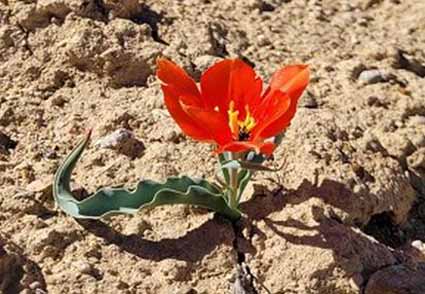Abstract
In this study, Tulipa sarvestanica (Liliaceae) is described and illustrated as a new species from south-western Iran. Tulipa sarvestanica differs from similar T. systola by having a smaller bulb with arachnoid bristles, smaller fruit (capsule) size, lower black blotch area at the base of the perianth, yellow anther versus purple anther in T.systola. The detailed description, diagnostic features, geographical distribution, habitat, original photographs, phenology, etymology, genome size, conservation status, and related species are presented in this study. Based on the IUCN criteria, the conservation status of Tulipa sarvestanica is classified as endangered (EN) species.
References
- APG (2016) An update of the Angiosperm Phylogeny Group classification for the orders and families of flowering plants: APG IV. Botanical Journal of the Linnean Society 181: 1–20. https://doi.org/10.1111/boj.12385
- Baitulin, I.O. (2014) Red Data Book of Kazakhstan, volume 2: plants. Apr PrintXXI, Astana, Kazakhstan.
- Baker, J.G. (1883) The species of Tulipa. –I. The Gardeners’ Chronicle 19: 626.
- Boissier, P.E. (1882) Tulipa. In: Flora orientalis, vol. 5. Georg, Geneva & Basle, pp. 191–201.
- Boissier, P.E. & Regel, E.A. (1873) Tulipa aleppensis. Trudy Imperatorskago S.-Peterburgskago Botaniceskago 2: 450.
- Boissier, P.E. (1859) Diagnoses plantarum orientalium novarum, vol. 4. Herrmann, Leipzig. 146 pp.
- Christenhusz, M.J.M., Govaerts, R., David, J.C., Hall, T., Borland, K., Roberts, P.S., Tuomisto, A., Buerki,S., Chase, M.W. & Fay, M.F. (2013) Tiptoe through the tulips - cultural history, molecular phylogenetics and classification of Tulipa (Liliaceae). Botanical Journal of the Linnean Society 172: 280–328. https://doi.org/10.1111/boj.12061
- Davletkeldiev, D.D. (2006) Red Data Book of Kyrgyz Republic, second edition. Bishkek, FAO NFPF.
- Don, D. (1836) Orithyia uniflora. In: The British Flower garden, ser. 2, 4. Ridgway, London, pp. 336.
- Everett, D., Fay, M.F., Christenhusz, M.J. & Wilford, R. (2013) The genus Tulipa. Tulips of the world. Kew Garden Press, London, 379 pp.
- Ghahreman, A., Attar, F. & Ghahremaninejad, F. (2007) A new species of Tulipa (Liliaceae) from western Iran. Novon 17: 437–439. https://doi.org/10.3417/1055-3177(2007)17[437:ANSOTL]2.0.CO;2
- Hall, A. (1929) The book of the tulip. Hopkinson, London, 224 pp.
- IUCN (2022) The IUCN Red List of threatened species, version 2021-3. Available from: https://www.iucnredlist.org (accessed: 24 November 2023).
- Khaleghi, A., Khadivi, A. & Zonneveld, B.J.M. (2018) Morphological variations among and within species of wild tulip (Tulipa L.) from Iran. Genetic Resources and Crop Evolution 65: 2241–2266. https://doi.org/10.1007/s10722-018-0688-4
- Linnaeus, C. (1753) Species plantarum. Salvius, Stockholm, 306 pp.
- Liu, J., Slik, F., Zheng, S. & Lindenmayer, D.B. (2022) Undescribed species have higher extinction risk than known species. Conservation Letters 15: e12876. https://doi.org/10.1111/conl.12876
- Masoud, S., Shirin, Z.F., Shadi, K. & Bahram, Z. (2002) Karyotypic study in some Iranian species and populations of Tulipa (Liliaceae). Caryologia 55: 81–89. https://doi.org/10.1080/00087114.2002.10589261
- Matin, F. & Iranshahr, M. (1998) A new species of the genus Tulipa (Liliaceae) from Iran. Iranian Journal of Botany 7: 228–229. https://doi.org/20.1001.1.1029788.1377.7.2.10.6
- Meier, U., Bleiholder, H., Buhr, L., Feller, C., Hack, H., Heß, M., Lancashire, P.D., Schnock, U., Stauß, R., Van Den Boom, T. & Weber, E. (2009) The BBCH system to coding the phenological growth stages of plants–history and publications. Journal für Kulturpflanzen 61: 41–52. https://doi.org/10.5073/JfK.2009.02.01
- Nowak, A., Świerszcz, S., Nowak, S., Hisorev, H., Klichowska, E., Wróbel, A., Nobis, A. & Nobis, M. (2020) Red List of vascular plants of Tajikistan – the core area of the mountains of Central Asia global biodiversity hotspot. Scientific Reports 10: 6235. https://doi.org/10.1038/s41598-020-63333-9
- POWO (2023) Plants of the World online. Facilitated by the Royal Botanic Gardens, Kew. Published on the Internet: http://www.plantsoftheworldonline.org/ (accessed: 24 November 2023).
- Reboul, E. de. (1847) Sulla divisione del genere Tulipa in sezione naturali. Giornale Botanico Italiano 3: 57–61.
- Stapf, O. (1885) Beitrage zur Flora von Lycien, Carien und Mesopotamien: plantae collectae a Dre Felix Luschan. Denkschriften der Kaiserlichen Akademie der Wissenschaften, Wien 50: 73–120.
- Tojibaev, K.S., De Groot, J.J. & Naralieva, N.M. (2014) Tulipa intermedia sp. nov. (Liliaceae) from the Ferghana Depression, Uzbekistan. Nordic Journal of Botany 32: 546–550. https://doi.org/10.1111/njb.00374
- Veldkamp, J.F. & Zonneveld, B.J.M. (2012a) The infrageneric nomenclature of Tulipa (Liliaceae). Plant Systematics and Evolution 298: 87–92. https://doi.org/10.1007/s00606-011-0525-0
- Veldkamp, J.F. & Zonneveld, B.J.M. (2012b) The nfrageneric nomenclature of Tulipa (Liliaceae). Plant Systematics and Evolution 298: 87–92. https://doi.org/10.1007/s00606-011-0525-0
- Zonneveld, B.J.M. & Van Iren, F. (2001) Genome size and pollen viability as taxonomic criteria: application to the genus Hosta. Plant biology 3: 176–185. https://doi.org/10.1055/s-2001-12900
- Zonneveld, B.J.M. (2009) The systematic value of nuclear genome size for “all” species of Tulipa L. (Liliaceae). Plant Systematics and Evolution 281: 217–245. https://doi.org/10.1007/s00606-009-0203-7


